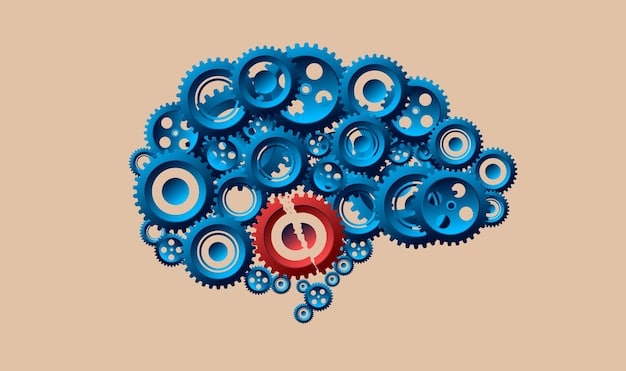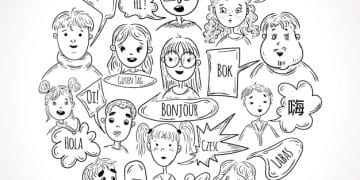Cognitive Dissonance: Justifying Beliefs Against Contradictory Evidence

Cognitive dissonance describes the psychological discomfort experienced when holding conflicting beliefs, values, or attitudes, compelling individuals to reduce this tension by altering their thoughts, behaviors, or perceptions of conflicting evidence.
Ever found yourself in a situation where your actions don’t quite align with your beliefs, or perhaps you encounter information that directly challenges a long-held conviction? This internal tug-of-war is at the heart of Understanding Cognitive Dissonance: How Do People Justify Their Beliefs in the Face of Contradictory Evidence? It’s a fascinating psychological phenomenon that impacts everything from our daily choices to major life decisions. We all experience it, often without even realizing the subtle ways our minds work to maintain a sense of internal consistency.
The Foundations of Cognitive Dissonance Theory
The concept of cognitive dissonance emerged from the pioneering work of social psychologist Leon Festinger in the 1950s. He proposed that humans have a fundamental drive to maintain consistency among their cognitions (beliefs, attitudes, and behaviors). When inconsistencies arise, they lead to an uncomfortable psychological state known as dissonance, which people are motivated to reduce.
Festinger’s theory wasn’t just a philosophical idea; it was rigorously tested through experiments. One of the most famous, conducted with Carlsmith, demonstrated how people who were paid very little to lie about a boring task later convinced themselves the task was actually enjoyable. This happened because the small payment wasn’t enough to justify the lie, creating dissonance that was resolved by changing their perception of the task itself.
Key Principles of Dissonance
Understanding cognitive dissonance starts with its fundamental principles. These principles explain why and how we strive for internal consistency, even when it means reinterpreting reality.
- Inconsistency as a Motivation: The presence of conflicting cognitions creates an unpleasant state that individuals are motivated to eliminate or reduce. This motivation is a driving force behind many of our choices and justifications.
- Magnitude of Dissonance: The strength of the dissonance experienced depends on the importance of the cognitions involved and the number of conflicting elements. A minor inconsistency might cause little discomfort, but a major one can lead to significant psychological stress.
- Reduction Strategies: People employ various strategies to reduce dissonance, often involving changing attitudes, beliefs, or behaviors. Sometimes, they even introduce new cognitions to bridge the gap between conflicting ideas.
Beyond experimental settings, cognitive dissonance is a pervasive aspect of human psychology, influencing our perceptions of fairness, our political views, and even our consumer choices. It highlights a core human need to perceive ourselves as rational and consistent beings, even when evidence suggests otherwise.
This fundamental drive to reduce internal conflict shapes much of our thought processes and decision-making, compelling us to reframe facts or adjust our perspectives to achieve a comfortable state of psychological equilibrium. The theory provides a robust framework for understanding various human behaviors, often revealing the subtle psychological maneuvers we employ to maintain a coherent self-image.
Classic Experiments and Real-World Examples
To truly grasp cognitive dissonance, it’s helpful to examine the seminal research that brought it to light and to see how it manifests in everyday life. These examples illustrate the powerful mental gymnastics people perform to reconcile conflicting information.
Festinger and Carlsmith’s 1959 study on “insufficient justification” remains a cornerstone. Participants performed a tedious task, then were asked to tell the next participant the task was interesting. Those paid $1 for this lie later reported enjoying the task more than those paid $20. Why? The $20 was sufficient external justification for lying, causing little dissonance. But the $1 group had insufficient justification, so they reduced their dissonance by internalizing the lie – convincing themselves the task was genuinely fun.
Further Experimental Insights
Other experiments reinforced and expanded on Festinger’s core ideas:
- Effort Justification: Aronson and Mills’ 1959 study showed that people who underwent a severe initiation to join a group rated the group more highly, even if it turned out to be boring. The effort expended caused dissonance (why suffer for something mundane?), leading them to justify their effort by valuing the group more.
- Post-Decision Dissonance: Brehm’s 1956 study on consumer choices found that after making a difficult decision between similarly attractive items, people tend to enhance the attractiveness of the chosen item and devalue the unchosen one. This reduces the dissonance of potentially having made the “wrong” choice.
In the real world, these principles are constantly at play. Consider a smoker who knows the health risks but continues to smoke. They might rationalize their behavior by saying, “My grandpa smoked until he was 90,” or “I could get hit by a bus tomorrow anyway.” This minimizes the psychological discomfort caused by the contradiction between their knowledge and their actions. Similarly, political supporters often dismiss credible negative news about their preferred candidate, labeling it as “fake news” or “biased,” to protect their commitment to that candidate. This rejection of contradictory evidence safeguards their existing belief structure, preventing the uncomfortable experience of dissonance. The mechanisms of dissonance are deeply integrated into our social and personal narratives, shaping how we process information and maintain our worldviews.

Mechanisms for Dissonance Reduction
When faced with the uncomfortable state of cognitive dissonance, individuals employ a range of strategies to restore psychological harmony. These mechanisms are often subconscious, serving to protect our self-concept and maintain an internal narrative of consistency.
Understanding these reduction methods is crucial to comprehending how people manage to hold onto beliefs despite compelling counter-evidence. It’s not about being illogical; it’s about a deep-seated need for psychological comfort.
Common Strategies Employed
The ways we reduce dissonance are diverse, each aiming to bring our cognitions back into alignment:
- Changing One of the Dissonant Cognitions: This is often the most straightforward way. If a person believes smoking is bad but smokes, they might quit smoking (changing behavior) or alter their belief about smoking’s harm (e.g., “It’s not that bad for *me*”).
- Adding New Consonant Cognitions: Introducing new beliefs or information that support one’s existing choice or behavior. The smoker might say, “Smoking helps me manage stress, and stress is also bad for health.” This adds a justification that lessens the conflict.
- Reducing the Importance of the Dissonant Cognitions: Downplaying the significance of the conflicting element. A person might dismiss health risks of smoking as exaggerated, making the dissonance less impactful. “Doctors are always exaggerating things.”
- Changing the Attractiveness of Alternatives: In post-decision dissonance, people often exaggerate the positive features of their chosen option and the negative features of the unchosen ones. “My new car is perfect, and that other one had so many issues anyway.”
These strategies allow individuals to navigate the complexities of life without constantly feeling internally conflicted. For example, individuals might rationalize supporting a political candidate despite policy disagreements by emphasizing other, more appealing aspects of their platform, or by downplaying the importance of the policies they dislike. This selective focus helps maintain a positive view of their chosen candidate, thereby reducing the mental discomfort. Such actions highlight a fundamental human drive to maintain a cohesive worldview, even if it requires reinterpreting or selectively attending to information, ensuring that our internal landscape remains as placid as possible. The mental work involved in these justifications can be quite intricate, reflecting a deep-seated need for psychological balance and self-integrity.
The Role of Self-Concept and Identity
Cognitive dissonance isn’t just about conflicting ideas; it’s deeply intertwined with our self-concept and identity. The more a belief or behavior is central to who we perceive ourselves to be, the stronger the dissonance when that belief or behavior is challenged. This connection explains why some justifications are so fiercely defended.
When someone attacks a core belief, it can feel like a personal attack, leading to stronger resistance to contradictory evidence. Our identity often dictates which cognitions are most important, and thus, which inconsistencies will generate the most psychological discomfort.
Dissonance and Personal Identity
Our self-narratives play a significant role in how we experience and reduce dissonance:
- Maintaining Self-Esteem: Many acts of dissonance reduction are aimed at protecting our self-esteem. We want to see ourselves as smart, moral, and rational. When our actions or beliefs contradict this image, dissonance arises, and we seek ways to restore that positive self-view.
- Belonging to Social Groups: Our group affiliations heavily influence our beliefs. If we identify strongly with a political party, a religious group, or a social movement, challenging the group’s tenets can create intense dissonance. Fearing exclusion or disapproval, we often align our personal beliefs with the group’s, even if it requires reinterpreting evidence.
- Moral Justification: When individuals act in ways that contradict their moral compass, they experience significant dissonance. To alleviate this, they might reframe their actions as morally acceptable under specific circumstances, or even alter their moral code to align with their behavior.
This dynamic interplay between dissonance and identity also illuminates phenomena like cult membership, where individuals sacrifice personal resources and relationships for a group that promises belonging and meaning. The extreme effort and commitment create immense dissonance if doubts arise, often resolved by intensifying belief in the cult’s ideology and rejecting external critics. It’s a powerful illustration of how strongly we are motivated to maintain consistency, especially when our core identity and sense of belonging are at stake. The cognitive effort to protect one’s self-image and group affiliation often outweighs the rational processing of contradictory evidence, solidifying existing frameworks of belief.

Cognitive Dissonance in Contemporary Society
In today’s hyper-connected world, where information is abundant and often conflicting, cognitive dissonance plays an increasingly significant role in shaping public opinion, political polarization, and personal development. The digital age, with its echo chambers and personalized algorithms, exacerbates the challenge of confronting contradictory evidence.
From climate change denial to vaccine hesitancy, understanding the psychological underpinnings of dissonance helps explain why people cling to beliefs even when faced with overwhelming scientific consensus.
Modern Manifestations
Contemporary society provides numerous examples of cognitive dissonance at work:
- Political Polarization: In deeply polarized environments, individuals often dismiss any information that challenges their chosen political ideology, regardless of its source or veracity. This “confirmation bias” is a form of dissonance reduction, protecting existing political identities.
- Conspiracy Theories: Adherents to conspiracy theories often exhibit strong cognitive dissonance. When presented with factual evidence disproving their theories, they may interpret it as further proof of a deep state cover-up, thus strengthening their initial belief.
- Consumer Behavior: Despite intentions to support ethical brands, many consumers continue to purchase from companies known for exploitative practices. The dissonance is reduced by rationalizations like “it’s too expensive to buy ethical products” or “my individual choice won’t make a difference.”
The rise of social media further amplifies these phenomena. Individuals can easily find communities that reinforce their existing beliefs, creating echo chambers where contradictory evidence is rarely encountered or immediately dismissed. This environment makes it harder for dissonance to arise, or when it does, it’s quickly resolved by re-engaging with like-minded content and discrediting opposing views. Understanding this dynamic is crucial for fostering critical thinking and promoting a more open-minded public discourse. The cognitive effort required to process conflicting information is often perceived as too high, given the availability of easier, confirmatory narratives within social networks, which further entrenches existing beliefs and resists change.
Overcoming Dissonance: A Path to Growth
While cognitive dissonance is a natural human response, an excessive reliance on dissonance reduction can hinder personal growth, critical thinking, and the ability to adapt to new information. Recognizing when we are experiencing dissonance and making a conscious effort to address it constructively can lead to greater self-awareness and intellectual flexibility.
The goal isn’t to eliminate dissonance entirely, as it can sometimes serve a protective function, but rather to manage it in a way that promotes learning and personal evolution. Engaging with contradictory evidence, even when uncomfortable, is a sign of intellectual courage.
Strategies for Constructive Engagement
To move beyond mere justification and embrace growth, consider these approaches:
- Cultivate Self-Awareness: Recognize when you are feeling the discomfort of dissonance. Acknowledge your initial defensive reactions without acting on them immediately. Ask yourself: “Why am I resisting this information?”
- Engage with Open-Mindedness: Actively seek out and genuinely consider perspectives that challenge your own. This doesn’t mean abandoning your beliefs, but understanding alternative viewpoints.
- Prioritize Accuracy Over Comfort: Be willing to revise your beliefs when presented with compelling evidence, even if it’s uncomfortable. Truth and accuracy should take precedence over maintaining a consistent, but potentially flawed, worldview.
- Practice Empathy: Understand that others also experience dissonance. Engaging in respectful dialogue, rather than aggressive confrontation, can create an environment where differing views can be discussed more productively.
- Reflect on Values vs. Behaviors: Regularly assess whether your actions truly align with your stated values. If not, consider if it’s time to change a behavior or re-evaluate a value.
Ultimately, navigating cognitive dissonance effectively is a continuous process of self-reflection and intellectual honesty. It means being comfortable with discomfort, recognizing that growth often comes from challenging our own assumptions. By doing so, we not only become more adaptable individuals but also contribute to a society that values critical inquiry and thoughtful discourse over blind adherence to ideology. The journey towards overcoming the more restrictive aspects of dissonance is a commitment to lifelong learning and a deeper understanding of both ourselves and the complex world around us. This deliberate engagement with discomfort cultivates intellectual resilience, fostering an environment where evolving perspectives are seen as strengths rather than threats. It allows us to move beyond simplistic justifications, forging a path toward genuine understanding and self-improvement.
| Key Aspect | Brief Description |
|---|---|
| 🤔 Origin of Dissonance | Psychological discomfort from holding conflicting beliefs or behaviors, as theorized by Leon Festinger. |
| 🛡️ Reduction Strategies | Changing beliefs/behaviors, adding consonant cognitions, or reducing importance of conflicting ones. |
| identity Link | Stronger dissonance when core beliefs tied to self-concept or group identity are challenged. |
| 🌱 Path to Growth | Cultivating self-awareness, open-mindedness, and prioritizing accuracy over emotional comfort to evolve. |
Frequently Asked Questions About Cognitive Dissonance
Cognitive dissonance is the mental discomfort experienced when a person holds two or more contradictory beliefs, values, or attitudes, or when their behavior contradicts their beliefs. This feeling of unease motivates individuals to reduce the inconsistency to restore psychological balance.
People reduce dissonance by changing their beliefs or attitudes, changing their behavior, or adding new cognitions to justify the inconsistency. They might also trivialize the importance of the conflicting cognitions, making the contradiction seem less significant.
No. While the discomfort itself is negative, the motivation to reduce dissonance can lead to positive outcomes, such as behavioral change (e.g., quitting smoking after recognizing health risks) or learning and personal growth through reconsidering long-held beliefs.
Social media can amplify cognitive dissonance by creating echo chambers where individuals are primarily exposed to reinforcing information, making contradictory evidence seem less credible. It also provides ready-made justifications and groups to validate existing beliefs, easing the reduction of dissonance.
Yes, understanding it can foster self-awareness, allowing you to recognize your own biases and justifications. It can also improve empathy by helping you understand why others cling to certain beliefs, facilitating more constructive discussions and critical thinking.
Conclusion
The journey through Understanding Cognitive Dissonance: How Do People Justify Their Beliefs in the Face of Contradictory Evidence? reveals a fundamental aspect of human psychology: our innate drive for internal consistency. From Festinger’s groundbreaking theories to its pervasive presence in contemporary society, cognitive dissonance shapes our perceptions, influences our decisions, and often dictates how we respond to challenging information. While the mental gymnastics we perform to reconcile conflicting thoughts can sometimes lead to rigid thinking, recognizing and consciously engaging with dissonance offers a powerful pathway to personal growth, intellectual honesty, and a more nuanced understanding of ourselves and the world around us. Embracing the discomfort of inconsistency allows us to evolve, adapt, and build a more informed worldview.





